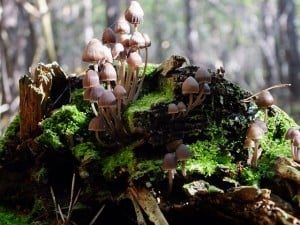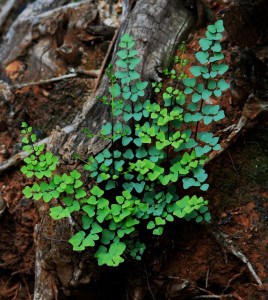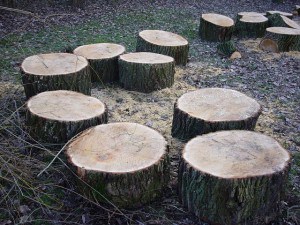Rotting Log Ecosystem and other Wildlife Friendly Ways with Logs
Old logs left to start rotting will create a haven for many different plants, bugs and wild creatures in your garden. From those that feed on the rotting wood and live in it, to those that eat these creatures in turn. The rotting log ecosystem will evolve and change as the wood decays, providing homes for many different creatures during that time.
To help you get started with this I will tell you about some ways to use logs in the garden. To keep it wildlife friendly make sure that none of the stumps or wood you use have been chemically treated. Once your logs or stumps are in place try not to disturb them. The wildlife will benefit most if these are just left alone for nature to take its course.

Stumpery, or Stump Garden
Stumps can be used to great effect as a feature I the garden. Whether this is a single stump or a few in a cluster, they will serve a purpose. The stumps you use can be cut sections of logs or tree stumps with the roots still on. The best way to use these is to dig them into the ground so that about 1 foot (30 cm) is under the ground. This will encourage rot and will keep them from falling over.
A stump with the roots on can be placed on top of the ground. If you want to use it above ground it will be best to place it on a bed of mulch, using leaves and sticks. I have also seen people place these stumps upside down, planted into the ground. This way they look very much like small dead trees and will also serve as perches for the birds.
If you don’t like the look of bare stumps you can inter-plant them with flowers, if they are in the sun or with ferns if they are in a shady spot. You can also plant a creeper or two to grow over the stump.

Fallen logs
You can also place a log or a few logs lying in the garden. You don’t want these to be too big, try to choose ones that have a diameter of no more than 20 cm. This will ensure that the spaces between the logs are not too big to be used by your wild visitors. If you only have a large log, you can place smaller logs or even a stick pile next to it to make it more useable. It could also form part of a rock pile or rock garden. Placing some leaves or sticks as mulch on the ground between the logs is also very beneficial.
Again you can plant other plants around the logs and cover them with a creeper if you want to disguise them. I quite like the look of a log pile in a corner of the garden, but feel free to cover it if it suits your garden better.
Wooden “disks”
If you can get a large tree stump, have somebody cut pieces that are about 10 to 20 cm thick. These “disks’ can be used in a pile by placing a few next to each other and then others on top covering the gaps between the bottom ones. It’s a bit like creating a series of caves. Mix them up with mulch and plants or put them around other features.

Variety is the key
To have a good variety of wildlife in your garden you need to create a variety of habitats to cater for their needs. There are many ways to use logs in the garden and I have only mentioned a few. I am sure you can think of some more ways.
The rotting log ecosystem that you create will change with each passing season. As the wood rots, different plants will grow on it and different creatures will use it as their home.
